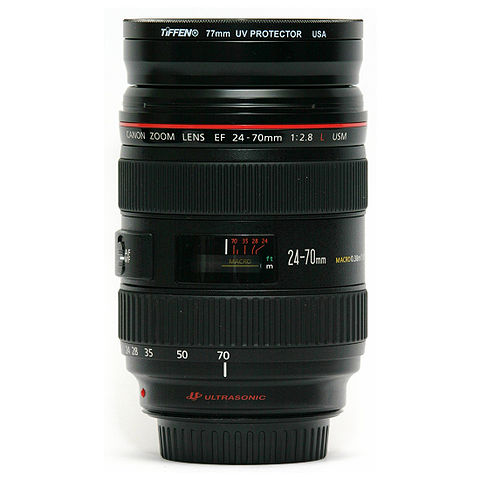Canon has just announced an updated, improved version of it’s high-quality EF 24-70mm f/2.8L standard zoom, called the EF 24-70mm f/2.8L II USM. (To understand what all the notions mean, please see my Canon Lens Notations post.)
Some would call this the full frame standard zoom, though as an EF lens it can also be used on non-full-frame cameras such as the 7D, 60D, and T3i/600D. The difference is that on non-full-frame bodies, it will act more like a 38-112mm focal length lens due to the crop factor of the smaller sensors.

New Canon 24-70mm f/2.8L II USM – (image from Canon USA)
Many, including myself, had hoped for – or even expected – this update to incorporate image stabilization, but this was not included. The image stabilization would have made it an even tougher decision between the new 24-70 f/2.8L II and the 24-105mm f/4L IS, which offers a similar focal length plus image stabilization, but has a minimum aperture of “only” f/4.0.
Canon states that the lens has been completely redesigned, and in addition to still offering great weather sealing like the original, the same .38m / 1.25 ft. minimum focus distance, and improved durability, it also now “features completely redesigned optics to provide outstanding clarity, image quality and durability. A compact design makes it ideal for carrying on every shoot, and a range of optical enhancements provide improved performance – capturing greater detail across the frame while reducing distortion throughout the entire zoom range, particularly at the maximum 70mm focal length.
With a redesigned optical system that includes two Ultra-low Dispersion (UD) and one Super UD aspheric elements to minimise chromatic aberration and colour blurring, the lens delivers consistently sharp, high-contrast images. Each lens element also features Canon’s optimised Super Spectra coatings to reduce ghosting and flare and ensure excellent colour balance. Additionally, a fluorine coating minimises the amount of dust, dirt and fingerprints that adhere to the front and rear of the lens, helping to maintain superior image quality.”
The original 24-70mm f/2.8L lens included “the use of two different types of aspherical lens elements and a UD (Ultra-low Dispersion) glass element for obtaining sharper image quality.” (quotes from Canon press releases)

Original Canon 24-70mm f/2.8L USM – (image from Cburnett, Wikipedia, GFDL license)
PLEASE do not put a cheap Tiffen filter on an L lens – use a high quality multi-coated B+W MRC filter
There are some significant differences in the design of the new lens vs. the older version. They both have ultrasonic motors for autofocus and full time autofocus (you can override the AF by turning the focus ring without switching to manual focus). And they both use an external zoom mechanism, meaning the lens extends as you zoom in and out. However, the original lens extended as you zoomed toward the 24mm wide end, which is “backwards” from a typical zoom lens. The new version acts as a more typical zoom, extending as you zoom towards the 70mm telephoto end. They both include a lens hood, though the older hood attached to the main section of the lens and the lens extends inside of the hood, thus working more effectively as a hood throughout the entire focal range from wide to tele. The hood of the new version attaches to the extending section, and thus is a smaller tulip style lens hood typical of most lenses. Perhaps the new coatings and lens elements make up for any internal reflections that might have resulted from this less effective hood. The new lens offers a lock switch for when it is retracted, though L lenses typically zoom so smoothly and tightly that they don’t tend to creep.
The sizes of the lenses are similar, though the new version is slightly shorter and lighter but wider. Due to the changed design, the new lens boasts a larger 82mm filter size. And the prices at this point are dramatically different. As far as the image quality, it is certain that the new 24-70mm is going to demonstrate dramatically improved image quality, especially when paired with the new Canon 5D MkIII (Canon 5D X?) when it comes out, as it is rumored to boast 30+ MP, which is going to require excellent glass to fully take advantage of.
24-70mm f/2.8L
3.3″ x 4.9″
2.1 lbs (950 g)
77mm filter size
$1,269 at B&H
$1,299 on Amazon
24-70mm f/2.8L II
3.5″ x 4.4″
1.77 lbs (805 g)
82mm filter size
$2,299 at B&H available for pre-order, expected in mid-April




